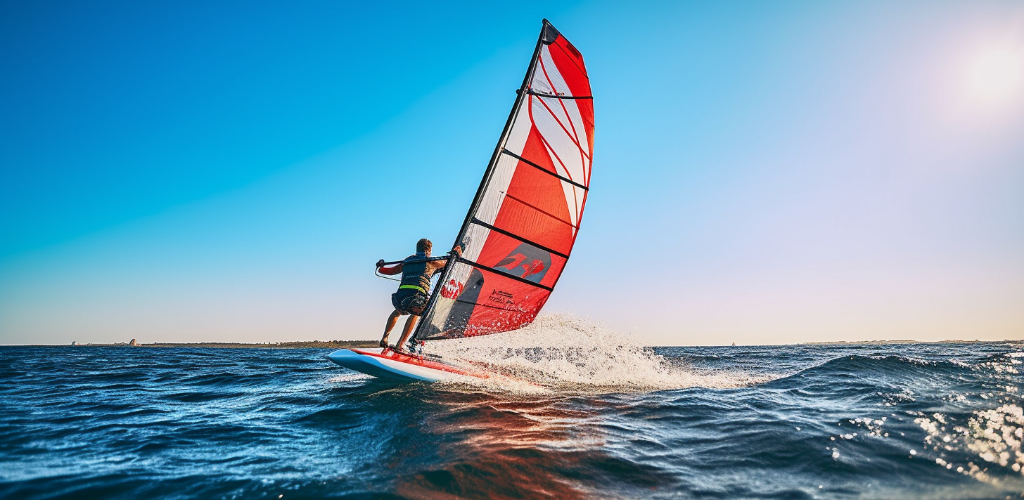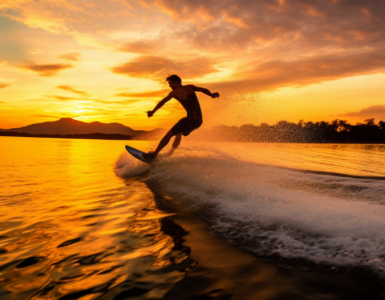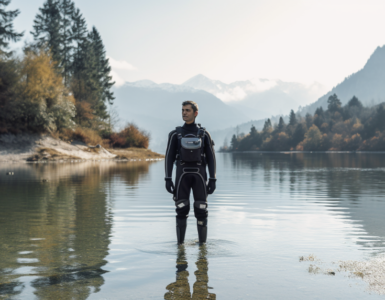Windsurfing is a thrilling water sport that has captured the interest of many adventure-seekers worldwide. Combining elements of both surfing and sailing, windsurfing allows the rider to harness the power of the wind, propelling themselves across the water on a specially designed board. But what exactly is windsurfing, and how did it evolve into the diverse sport that we see today?
There’s nothing quite like the exhilaration of catching a gust of wind and zipping across the water’s surface. If you’re curious about this exciting water sport, you’ve come to the right place. Let’s dive into the captivating world of windsurfing!
The Evolution of Windsurfing
The sport of windsurfing has a rich history that dates back to the mid-20th century. It all began in the 1960s when innovative minds sought to merge the thrill of surfing with the control of sailing. With the introduction of the sailboard, a new era of water sports was ushered in, giving birth to the exciting world of windsurfing we know today.
Over the decades, the sport has evolved significantly, with advances in technology and design leading to the development of various styles of windsurfing. From freestyle and wave riding to racing and slalom, the sport has something to offer for everyone, regardless of their skill level or interests.
Basic Terminology
Like any sport, windsurfing has its own unique set of terms and jargon. Understanding these terms is essential for anyone looking to delve into this exciting water sport. Here are a few basic terms you should know:
Sail: The sail is the most prominent part of a windsurfing setup. It’s the component that catches the wind and propels the board forward. It’s connected to the mast and controlled by the boom.
Mast: The mast is the vertical pole that supports the sail. It’s typically made of a lightweight, durable material like carbon fiber or aluminum.
Boom: The boom is the horizontal bar attached to the mast and sail. It’s what the windsurfer holds onto while riding, allowing them to control the sail’s angle and power.
Foot Straps: Foot straps are attached to the board and allow the windsurfer to secure their feet, providing better control and balance while riding.
There’s a lot more to learn, but these basic terms should give you a good starting point. Interested to know more? Stick around as we delve deeper into the world of windsurfing!
Different Board Types
Ever wondered about the different kinds of boards that windsurfers use? Well, boards come in all shapes and sizes, each with unique features that make them ideal for specific conditions and styles of windsurfing. The two main types of boards are longboards and shortboards.
Longboards
Longboards, as their name suggests, are longer and often wider than their shortboard counterparts. They are perfect for beginners because they offer more stability, making it easier to balance and control. But don’t let their size fool you! They’re not just for novices. Many experienced windsurfers enjoy longboarding for its versatility and ease of use in light wind conditions.
Longboards also offer the added advantage of being able to be used for traditional surfing in the absence of wind. So, if you’re looking for a board that can do it all, a longboard might be the choice for you.
Shortboards
On the other side of the spectrum, we have shortboards. These boards are lighter, smaller, and designed for high-speed and advanced maneuvers. They are ideal for more experienced windsurfers who wish to take advantage of strong wind conditions, and perform tricks and jumps.
Shortboards offer a more challenging, yet thrilling experience. They require more skill to control, but once mastered, they can provide a truly exhilarating ride. Imagine slicing through the waves at high speed, the wind in your hair, and the thrill of performing jaw-dropping tricks!
Different Sail Types
Just as there are different types of boards, there are also various types of sails. The sail is a critical component of the windsurfing setup as it influences the speed, stability, and maneuverability of the ride. The type of sail used largely depends on the conditions and the windsurfer’s skill level and style.
Let’s take a look at some of the most popular types of windsurfing sails:
| Sail Type | Description | Best Used For |
|---|---|---|
| Wave Sails | These are robust, maneuverable, and relatively small sails. They are designed to withstand the powerful forces of the waves and wind. | Best for high wind and wave conditions. Ideal for tricks and jumps. |
| Freeride Sails | These are all-around sails. They are versatile and easy to handle, offering a balance between speed, power, and control. | Great for leisure windsurfing on flat water or in moderate wave conditions. |
| Race Sails | These are the largest and most potent sails. They are designed for speed and efficiency but require skill to control. | Perfect for racing and high-speed windsurfing in a variety of conditions. |
Choosing the right sail can make all the difference in your windsurfing experience. So, whether you’re looking for the speed of a race sail, the versatility of a freeride sail, or the robustness of a wave sail, there’s a perfect sail out there waiting for you.
The Diverse Styles of Windsurfing
Did you know that windsurfing is a multifaceted sport with a variety of styles? That’s right! Just as the winds have their moods, so does windsurfing. This diversity makes the sport accessible and enjoyable for all, irrespective of one’s skills, interests, and conditions. Let’s explore some of these styles, shall we?
Recreational Windsurfing
Recreational windsurfing is all about enjoying the sport without the pressure of competition. It is perfect for those who simply want to feel the thrill of catching the wind, gliding across the water, and enjoying the freedom and tranquility that comes with it. Recreational windsurfing allows you to set your own pace, learn at your own speed, and just have a great time.
Competitive Windsurfing
Are you the competitive type? Then competitive windsurfing might be the style for you. This style of windsurfing is for those who thrive on competition and the adrenaline rush that comes with it. The world of competitive windsurfing is vast, with professional competitions held around the world, and even a spot in the illustrious Olympic Games. It’s a thrilling arena, but remember, it requires dedication, training, and a love for the sport.
The Skills Required for Different Windsurfing Styles
Just like any other sport, windsurfing requires a certain set of skills. But what’s interesting is that these skills can vary depending on the style of windsurfing you choose. Some styles might require more balance, while others might demand more strength or agility. Curious to know what skills are needed for different windsurfing styles? Let’s have a look.
- Balance: This is crucial for all styles of windsurfing. You need to maintain your balance on the board while maneuvering the sail and harnessing the power of the wind.
- Strength: Windsurfing is a full-body workout. It requires good upper body strength for handling the sail, as well as lower body strength for controlling the board.
- Agility: This is especially important in styles like wave riding or freestyle where quick, fluid movements are key.
- Endurance: Windsurfing can be quite demanding. Whether you’re racing against others or just out for a leisurely ride, having good endurance will help you enjoy the sport for longer periods.
- Knowledge of the wind and waves: Understanding how to read the wind and waves is an essential part of windsurfing. It helps you navigate and make the most of your time on the water.
Section 4: Understanding Windsurfing
The Role of Weather Conditions in Windsurfing
Ever wondered how the weather impacts your windsurfing experience? Well, it plays a significant role. Wind speed, direction, and wave conditions can dramatically influence your performance and enjoyment of the sport. Just like sailing, windsurfing is all about harnessing the power of the wind. So, the stronger the wind, the faster you’ll go. But be careful, as very strong winds can also make control more challenging!
Wind direction is another crucial factor in windsurfing. Certain directions can create ideal conditions, while others can make windsurfing more difficult. For instance, an onshore wind (a wind blowing from the sea towards the land) is generally safer because if you get into trouble, the wind will push you back towards the shore.
Lastly, wave conditions can impact the type of windsurfing you’ll do. Flat water is perfect for beginners and freestyle windsurfing, while big waves are a playground for wave riders. Fascinating, isn’t it?
Safety Considerations in Windsurfing
As with any sport, safety is paramount in windsurfing. It’s not just about having fun; it’s about staying safe while having fun. Here are a few safety considerations:
- Wear appropriate gear: A suitable wetsuit, lifejacket, and helmet can protect you from the elements and potential injuries.
- Understand weather patterns: Be aware of the forecasted wind and wave conditions before you set out. It’s important to know when conditions are too dangerous for your ability level.
- Use a safety leash: A leash connecting you to your board can prevent losing your board if you fall off.
- Learn the right of way rules: Knowing who has the right of way can prevent collisions on the water.
- Take lessons: A qualified instructor can teach you the basics of windsurfing and safety procedures.
Getting Started with Windsurfing
Feeling excited about windsurfing? Ready to dive in? Here are some tips to help you get started:
Firstly, find a good teacher. A qualified instructor can guide you through the basics and help you avoid common beginner mistakes. They can also teach you about safety, which is crucial in this sport.
Secondly, choosing the right equipment is essential. As a beginner, you’ll want a large, stable board and a small, manageable sail. As you progress, you can upgrade to more advanced equipment.
Finally, select the appropriate type of windsurfing for your skills and conditions. Don’t rush into wave riding or freestyle windsurfing; start with recreational windsurfing and gradually progress to other styles as you gain confidence and skills.
In conclusion, windsurfing is a diverse and exciting sport. Whether you’re into peaceful cruising, performing tricks, or riding waves, there’s a type of windsurfing for you. So why not give it a try? With the right approach and mindset, you’re sure to have a blast!




